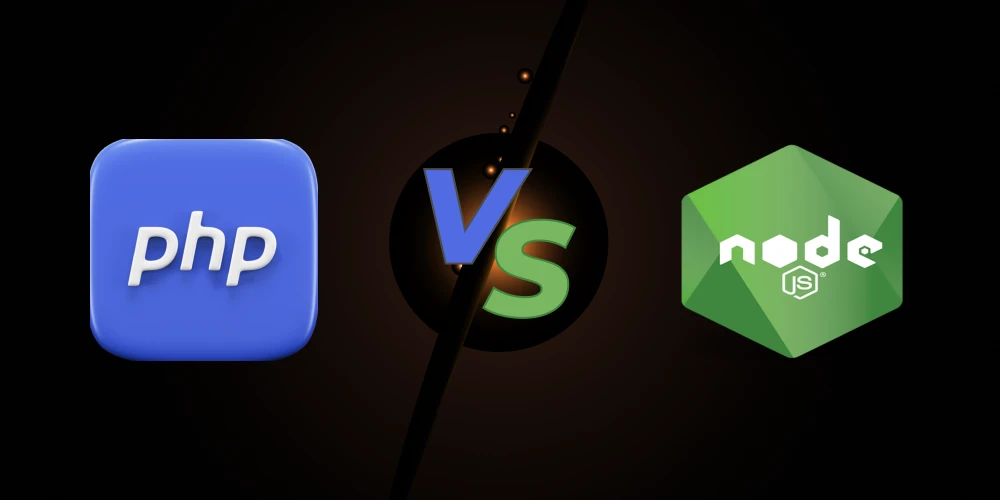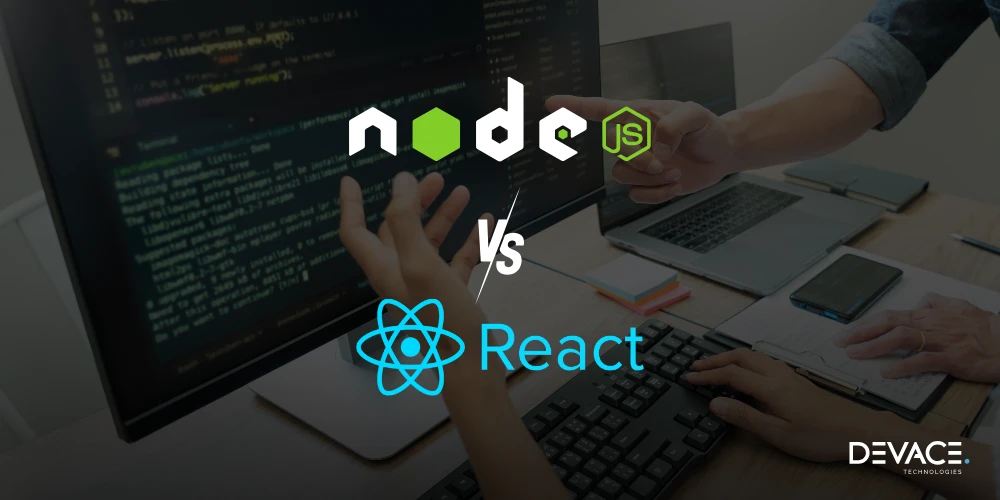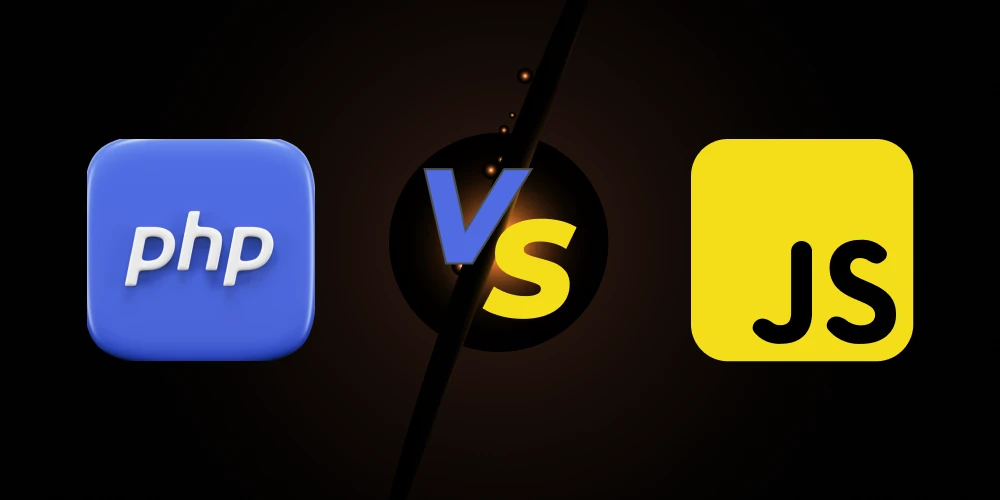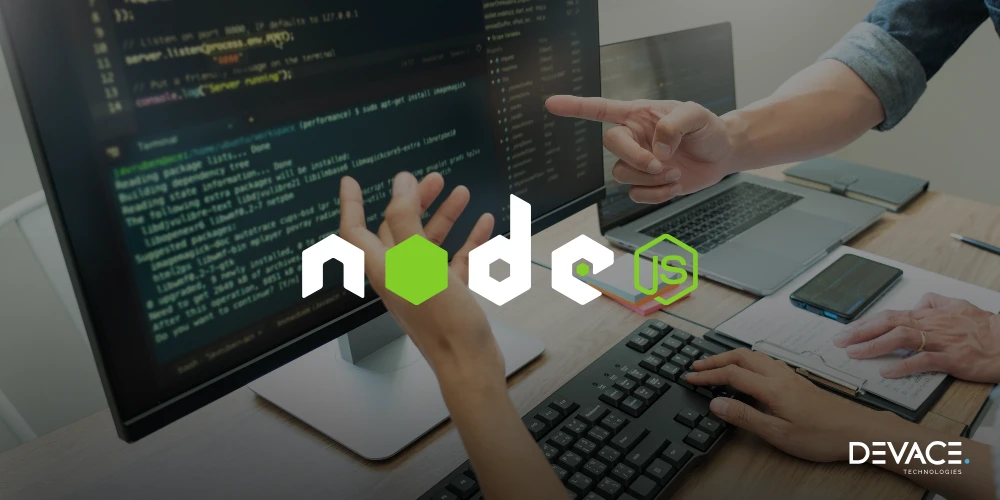PHP and Node.js go back a long way. However, with technical advancements and other factors, there was huge competition between the two and users were confused which one to choose for top-notch development.
If you’re looking for a direct answer, here is a quick takeaway:
Both technologies, i.e., PHP and Node.js, are popular for server-side development. However, they differ in some of the main aspects such as architecture and use cases.
PHP is a more of a mature, synchronous scripting language that is used for projects like web development, content management system (CMS) development, and traditional LAMP stacks.
Whereas,
Node.js is a modern and asynchronous JavaScript runtime framework that is specifically designed for building scalable, and real-time applications that make it an ideal backend framework for chat apps and steaming services.
If we talk about it from a learning point of view, PHP is easier for beginners, and it is perfect for content-based websites. Node.js offers faster performance for handling multiple connections at the same time.
Both are powerful but serve different project requirements based on scalability and performance needs.
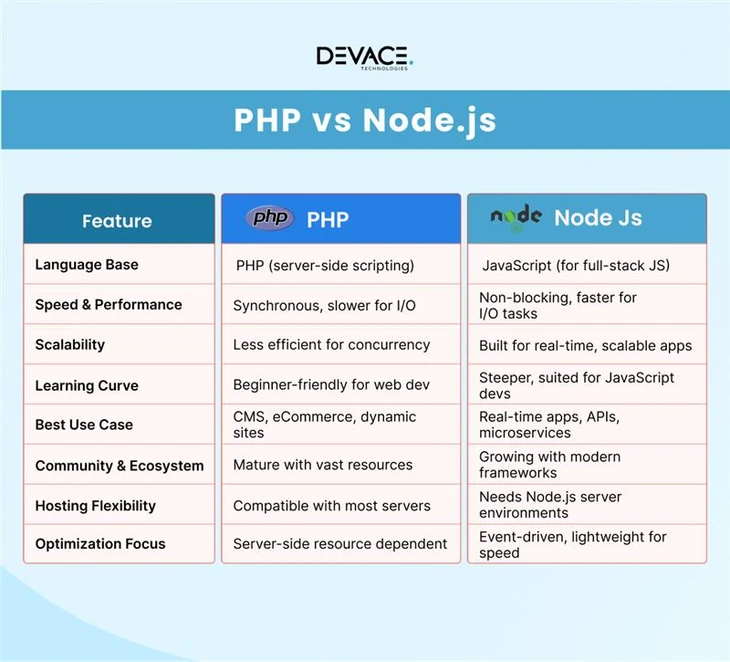
But, for better understanding, it is better to go in-depth about these two frameworks i.e., PHP vs Node.js, and get to know it from the core.
What is PHP?
It stands for Hypertext preprocessor which is a widely used open-source scripting language mainly used for web development. This framework is directly embedded into HTML which makes the development of dynamic pages easier for developers.
It executes code on the server side – which means that the server processes the PHP code and sends the results to the user’s browsers.
If you are thinking, what is it known for? Then the answer is compiled in two words: i.e., simplicity and versatility. In addition to that, it also supports various databases like MySQL, PostgreSQL, and SQLite, making it ideal for building web applications, content management systems, and eCommerce platforms.
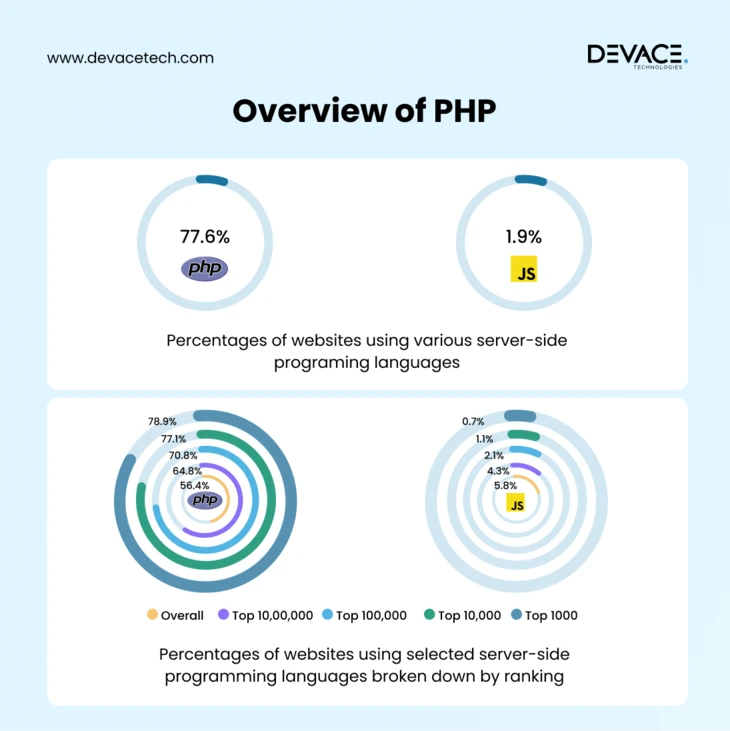
Now, you know about it, shall we talk a little bit about the history of PHP because a little bit of history is never bad!
History of PHP
It was in 1994 when PHP was created by Rasmus Lerdorf when a simple set of CGO scripts were written in C to manage his website.
Did you know that before Hypertext Processor, its full form was Personal Home Page Tools, and since then it has significantly evolved?
After three years i.e., in 1997, PHP/FI (Forms Interpreter) was introduced, marking its first public release as a scripting language capable of database interaction and basic web functionalities. And then the rest is history!
In 1998, PHP/FI PHP 3.0 was another significant signal that showed the continuous evolution and growth of PHP as a general-purpose scripting language with a new parser!
Fast forward to 2000, PHP 4.0 introduced the Zend Engine which significantly helped in improving performance and modularity.
Now, it’s 2004 and PHP added better object-oriented programming (OOP) support/
By 2015, PHP 7 was introduced which presented major performance improvements and reduced memory usage, and in 2020 PHP 8 added the Just-In-Time (JIT) compiler and modern language features like named arguments and match expressions.
Top Features of PHP
PHP, to this date, stands as a strong choice for developers, SMBs, and enterprises due to its robust features. Below are a few PHP features that would help you to know about it.
Open-source and Free
One of the top features of PHP is that it is open source (translates into completely free to download and use) which makes it a cost-effective solution for web development, especially for SMBs.
If there is a project, developers can access the source code, modify it, and contribute to it in case there are any changes or modifications required. There are multifaceted benefits to it such as encouraging collaboration and continuous enhancements from a global community of developers.
Because PHP is open source, it also reduces development costs, especially for those businesses who have just started it. But it does not mean that enterprises or large-scale projects shouldn’t or can’t use PHP, as it has still a lot of powerful features for kind of projects.
Server-side Scripting
As mentioned above, it’s a server-side scripting language which means that the code is processed on the web servers rather than the client’s browser. So, what happens is that when a PHP script runs, the server processes it and generates HTML content that is then sent as a result to user query at the user’s browser.
This process enhances security (as a user cannot see the source code and sensitive operations, database queries, or authentication) and also user experience by improving the performance as the client only receives the rendered HTML rather than executing the code themselves. Below is an example for understanding:
<?php echo "Welcome to my website!"; ?>
In this case, the user will only see “Welcome to my website!” in the browser, not the PHP code itself.
Cross-Platform Compatibility
Having cross-platform compatibility is one of the biggest advantages that businesses seek. As PHP is platform-independent, it can seamlessly run on different operating systems and web servers without any modification required.
So, whether developers are working on a Windows machine, a macOS setup, or a Linux server, PHP will continue to function consistently and efficiently.
Developers prefer PHP especially when they are looking for a flexible backend without being locked into a particular operating system or software. It is compatible with various popular web servers like:
- Apache
- Nginx
- Microsoft IIS
This feature makes it easier to deploy PHP applications across multiple environments during development, staging, and production.
Database Integration
Having database integrations makes the development process seamless. It is a powerful offer of PHP as it offers built-in support for various relational and NoSQL databases, making it highly versatile for dynamic web development. Developers can easily connect PHP with MySQL, PostgreSQL, SQLite, MongoDB, and Oracle databases.
By connecting database integration with PHP, a website solution can handle tasks like fetching and displaying user data, managing eCommerce transactions, and storing form submissions.
Below, I have given a simple database connection using MySQL:
<?php
$conn = mysqli_connect("localhost", "username", "password", "database");
if (!$conn) {
die("Connection failed: " . mysqli_connect_error());
}
echo "Connected successfully!";
?>
This feature is important to understand for creating dynamic sites where content needs to change based on user interactions or stored data.
Simple and Easy to Learn
PHP is a top choice for beginners as it has a simple syntax that is easy to learn. It is compared to C and JavaScript, making it easier for those with basic programming knowledge to get started. Here is how it is simple:
- Minimal setup is required for basic web projects.
- The syntax is easy to read and write.
- PHP code can be directly embedded into HTML, reducing complexity for web developers.
Below, we have written an example, adding PHP into HTML page:
<html> <body> <h1>Welcome, <?php echo "John Doe"; ?></h1> </body> </html>
Extensive Library and Built-in Functions
Another top feature of PHP is that it provides a vast collection of built-in libraries and functions that handle common programming tasks without requiring additional code. By using an extensive library and built-in features or functions of PHP you can cover tasks like:
- String manipulation: str_replace(), strlen(), strpos()
- File handling: fopen(), fwrite(), file_get_contents()
- Mathematical operations: round(), abs()
- Date and time functions: date(), time()
Below is an example of string manipulation that you can follow to understand:
<?php
$text = "Hello World!";
echo str_replace("World", "PHP", $text); // Output: Hello PHP!
?>
Security Features
With the growing security threats, it is essential to maintain data integrity and security of users. With that in consideration, PHP offers multiple built-in features and mechanisms to help protect websites from vulnerabilities. The top PHP security features include SQL injection protection, XSS protection, encryption support, and many other techniques.
Below is an example of secure password hashing:
<?php $password = "userpassword123"; $hashedPassword = password_hash($password, PASSWORD_DEFAULT); echo $hashedPassword; ?>
PHP also allows developers to customize error handling, logging, and input validation, all essential for securing web applications.
Flexibility and Extensibility
For customization and to extend functionalities, PHP frameworks and libraries can be easily used. It allows developers to build web applications faster while following best practices.
Some of the popular PHP frameworks include Laravel, Symfony, and CodeIgniter.
Laravel vs Symfony: Which Is the Best PHP Framework?
Developers can also extend PHP with third-party packages from Composer, a dependency manager for PHP, which makes it easier to manage and integrate external code.
Large Community Support
Having global and active developer communities helps frameworks and languages grow. With that being said, PHP is also one of the backend frameworks that have the most active and largest communities.
These communities offer extensive documentation, forums, Q&A sites, frequent updates, and learning resources.
Extensive documentation is available in the communities so that developers can utilize it to understand functions and features. In addition to that, in the developer community of PHP, it provides resources like Stack Overflow, PHP.net, and GitHub for resolving any issues that developers might face.
Also, if PHP gets updates in the form of security patches and language improvements, the PHP community is there to have it all done.
Not only that but beginners can also get countless tutorials, courses, and other support from the PHP community that can help them get started.
Who Uses PHP?
PHP is used in many industries for its powerful features explained above. The following are the use cases of PHP:
- Content Management Systems (CMS): WordPress, Joomla, and Drupal are powered by PHP.
- Social Media Platforms: Facebook originally used PHP for its core development.
- eCommerce: Magento and WooCommerce are PHP-based platforms.
- Web Applications: Sites like Wikipedia and Slack have PHP components.
- Freelancers and Small Businesses: PHP’s ease of use and low cost make it popular among small businesses for website development.
- Large Enterprises: Companies like Yahoo, Tumblr, and MailChimp have used PHP for scalable web services.
Below are the most popular companies that use PHP:
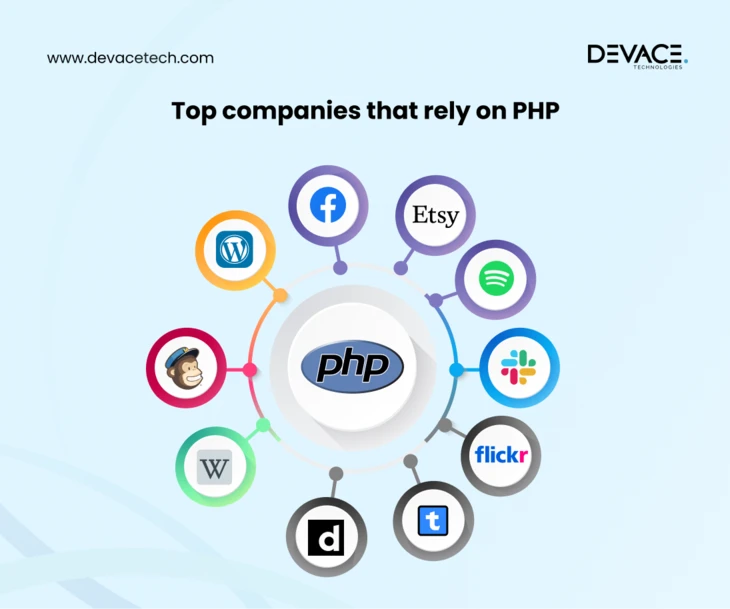
Now, let’s discuss Node.js to understand how both frameworks differentiate from each other.
What is Node.js?
It is an open-source cross-platform JavaScript runtime environment that is built on Chrome’s V8 JavaScript engine. Node.js allows developers to run JavaScript code outside the browser, primarily for server-side scripting.
Node.js also offers features like event-driven, non-blocking architecture that enable developers to build scalable network applications. It enables the creation of dynamic web servers, APIs, and real-time applications like chat applications and streaming platforms.
The market popularity of Node.js is increasing day by day. The picture added below shows the website built on Node.js which also reflects the market share.
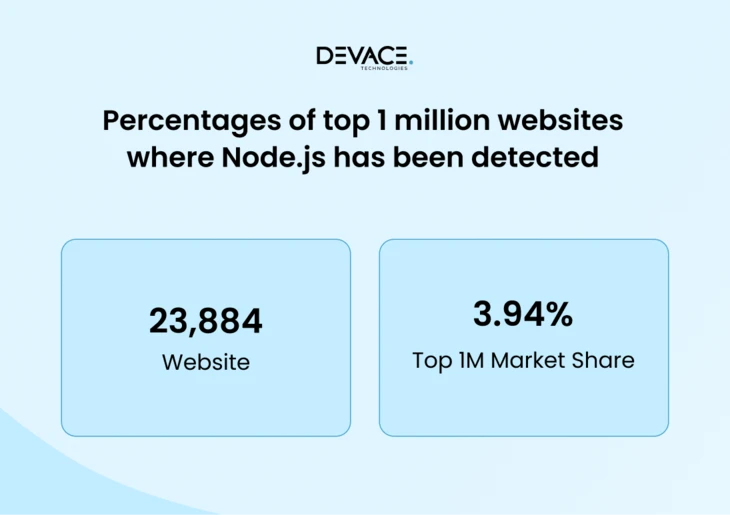
In addition to that, the market share for Node.js has increased by 0.446% points i.e., it was 0.803% and now it is 1.249% for all websites. It is more than any segment at the same time.
Related Blog: What is Node.js and Why Should You Use It?
History of Node.js
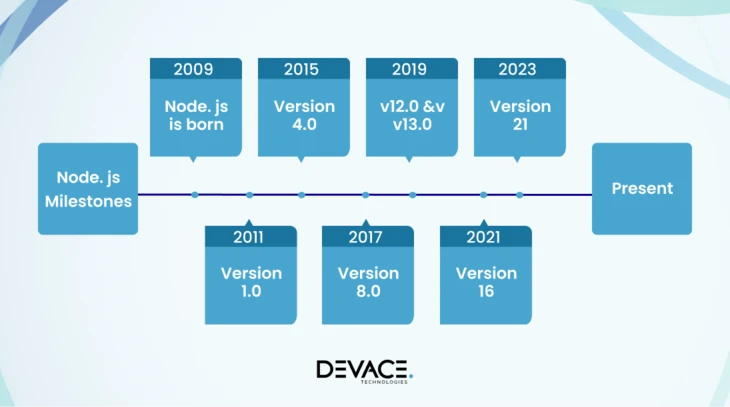
In 2009, Ryan Dahl created Node.js as a solution for handling asynchronous operations with efficiency on the server side. Before Node.js was released, JavaScript was limited to client-side scripting whereas the server-side programming relied on PHP (as we have mentioned above). But it led to performance issues with handling multiple concurrent connections.
When Node.js entered the picture – things changed! Its release also introduced Node Package Manager (NPM) that allows developers to share and manage open-source libraries, further driving its adoption in the developer community.
In 2019, an OpenJS Foundation was formed to talk about the key events they have focused on performance improvements, better developer tools, and enhanced security features.
Major milestones in the history of Node.JS include the introduction of ECMAScript module support in Node.js 14, native Fetch API and a built-in Test Runner in Node.js 18, and security enhancements with a permissions model in Node.js 20.
To this date, Node.js is a leading choice for developers and business owners as it provides scalable solutions for modern web development, building scalable APIs, microservices, and real-time applications, supported by a vast ecosystem and a dedicated global community.
Key Features of Node.js
The key features of Node.js include asynchronous and non-blocking I/O, single-threaded, event-driven, V8 Engine, Cross-platform compatibility, and many others. Let’s discuss them briefly.
Asynchronous and Non-Blocking I/O
It follows a non-blocking and asynchronous architecture that enables tasks to run in parallel without waiting for previous operations to be completed. It has several benefits such as greatly improving the performance of I/O-heavy tasks such as database queries, API requests, and file operations. e operations.
So here is an example for your understanding i.e., instead of waiting for a database query to complete before handling the next request, Node.js allows multiple tasks to run simultaneously. This feature of NodeJS helps reduce latency and improves server responsiveness, making it suitable for applications requiring real-time interactions.
Sigle-Threaded and Event Driven
Another top feature of Node.js is that it operates on a single-threaded loop event by using non-blocking calls. It has an event-driven architecture that helps manage multiple client requests efficiently, and developers wouldn’t even need a new thread for each incoming request which would consume more memory and CPU resources.
The event loop mechanism of Node.js makes sure that the tasks like HTTP requests, file operations, and database interactions are managed concurrently, providing better throughput.
Cross Platform Compatibility
As Node.js is an independent platform, it runs seamlessly on different operating systems such as Windows, MacOS, Linux, and Unix. It gives flexibility to developers to write code once and then deploy it across multiple environments without significant changes. Additionally, NodeJS is compatible with major web servers like Nginx and Apache which makes it easier for developers to integrate into existing infrastructure.
Node Package Manager
The Node.js backend framework has a Node Package Manager that is considered one of the world’s largest repositories of open-source libraries and tools for JavaScript. What it does is that it simplifies dependency management and accelerates the development progress by providing reusable modules for tasks like:
- Express.js: Web server framework
- Mongoose: MongoDB object modeling
- Socket.io: Real-time communication
- Lodash: Utility functions for JavaScript
Developers can easily share, version, and manage packages, ensuring more efficient and collaborative development. Isn’t this just great?!
V8 Engine
It is powered by the V9 JavaScript engine which is developed by Google. It is known for its speed and efficiency.
This engine compiles JS code directly into machine code rather than interpreting it which improves the execution speed.
This performance boost makes Node.js suitable for building high-speed applications such as gaming servers, data-intensive APIs, and streaming services.
Scalability
Well did you know that Node.js is inherently designed for stability making it suitable for both small and enterprise-level projects? It has event-driven architecture and non-blocking I/O that allow it to handle thousands of simultaneous connections with minimal resource consumption.
It also supports features like clustering i.e., running multiple instances of Node.js on a multi-core processor and another is load balancing i.e., distributing incoming traffic across multiple servers.
These features make Node.js ideal for building distributed systems and microservices architectures.
Microservices and API Development
Another feature that we have in the top features of Node.js is that it is widely used for API development. You can create RESTful APIs and microservices using its lightweight architecture. It also can handle multiple concurrent requests which makes it an excellent choice for building API that serves frontend frameworks like React, Vue, and Angular. There are certain popular frameworks for Node.js API development including Express.js (minimalist web server frameworks), NestJS (scalable microservices framework), and Koa.js (lightweight server-side framework).
Streaming Support
Streaming data requires high performance and need backend that can make it seamless. Node.js provides efficiency for streaming data which makes it ideal for projects like video streaming platforms, file uploading and downloading platforms, and audio processing.
It uses readable and writable streams, allowing data to be processed in chunks rather than waiting for the entire file to load, reducing memory usage and improving performance.
Real-time Data Handling
Another top feature of Node.js is that it excels in real-time data processing, especially for those applications that require instant data exchange. This feature has proven to be beneficial for chat applications, gaming servers, collaborative tools, and stock market dashboards.
Technologies like WebSockets and Socket.io work seamlessly with Node.js, allowing bi-directional communication between clients and servers for real-time updates.
Large Community and Open-Source Support
Node.js also has a vast and active developer community that contributes to continuous growth and security improvements. Whether beginners or experts, Nod.js developers can access various formats to get support from the large and global community in the forms of official documentation, GitHub repositories, forums, and Q&A sites.
It stays updated, secure, and beginner-friendly, making it a reliable choice for developers at all levels.
Who Uses Node.JS?
Node.JS is considered the best for enterprise-scale projects as it is ideal for building microservices, APIs, and real-time applications that make it popular accross industries.
Below are the top companies that use Node.js for its scalability and speed in handling high-traffic applications.
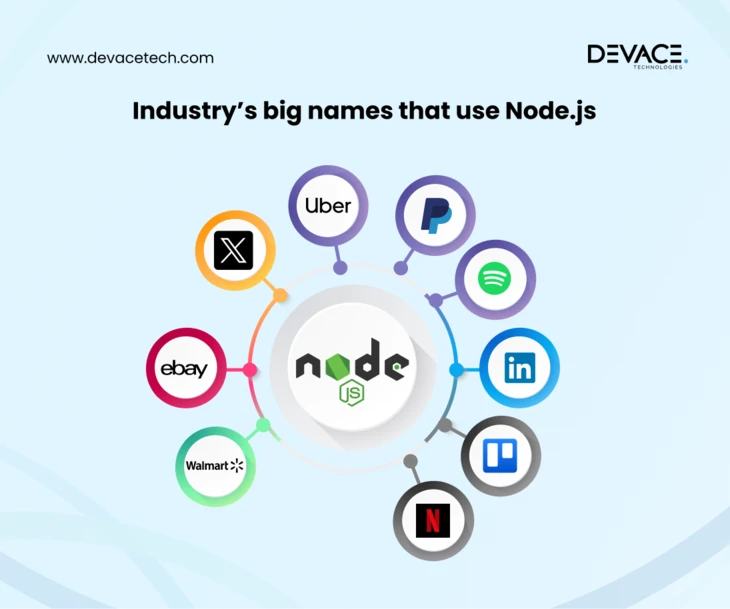
PHP vs Node.js: Key Differences in Two Backends
Below is the table that highlights the key differences between PHP vs Node.js in features like performance, concurrency handling, ease of leaning, language, frameworks, and much more.
| Aspect | PHP | Node.js |
|---|---|---|
| Type | Server-side scripting language | JavaScript runtime environment |
| Performance | Slower due to synchronous nature | Faster with non-blocking I/O |
| Concurrency Handling | Multi-threaded, blocking I/O | Single-threaded, non-blocking I/O |
| Ease of Learning | Easier for beginners | Slightly steeper learning curve |
| Best Use Case | CMS, blogs, web servers | Real-time apps, APIs, microservices |
| Language | PHP-specific | JavaScript (JS-based) |
| Frameworks Available | Laravel, Symfony, CodeIgniter | Express.js, Nest.js, Meteor |
| Hosting Support | Widely supported (cPanel, shared) | Requires specialized support (VPS) |
| Database Support | MySQL, PostgreSQL, MariaDB | MongoDB, PostgreSQL, MySQL |
| Scalability | Limited due to the synchronous nature | Highly scalable due to async I/O |
| Community Support | Large and mature community | Growing and modern community |
| Development Speed | Faster for standard web projects | Faster for modern, real-time apps |
| Error Handling | Traditional error reporting | Advanced error handling with promises |
| Security | Mature security practices | More prone to vulnerabilities if not handled properly |
PHP vs Node.js: Key Similarities in Two Backends
The table below highlights the similarities between PHP and Node.js in terms of server-side scripting, open source, cross-platform support, package management, and much more.
| Feature | PHP | Node.js |
|---|---|---|
| Server-side Scripting | Yes, used for backend web development | Yes, commonly used for backend scripting |
| Open Source | Yes, open-source and community-driven | Yes, open-source and community-driven |
| Cross-Platform Support | Yes, works on multiple operating systems | Yes, works on multiple operating systems |
| Scalable for Web Apps | Yes, scalable for large web applications | Yes, scalable for large web applications |
| Database Integration | Yes, it supports MySQL, PostgreSQL, etc. | Yes, it supports MongoDB, MySQL, etc. |
| Package Management | Composer for dependency management | NPM for dependency management |
| Syntax Similarities | Both use C-style syntax patterns | Both use C-style syntax patterns |
| Community Support | Large developer community | Large developer community |
| Object-Oriented Programming | Yes, supports OOP concepts | Yes, supports OOP concepts |
| Security Features | Built-in security libraries | Built-in security libraries |
What’s the Final Verdict: PHP vs Node.JS?
PHP and Node.js are powerful backend frameworks for server-side development that excel in their aspects. However, PHP is ideal for content-driven websites, CMS platforms, and traditional web development.
But if you want dynamic and modern websites that are scalable, and can handle high traffic, then Node.JS is the best choice.
If you want to choose one between PHP and Node.js, it depends on project requirements—PHP suits simpler, database-driven sites, whereas Node.js is better for modern, high-performance web apps. Ultimately, both can deliver robust web solutions when used in the right context.
Hire Developers from Devace Technologies
Are you looking for top developers that can help you scale your project? Look no other than Devace Technologies, we enable you to hire top developers within 48 hours. Our five-step hiring process makes the process smoother as you can choose from our engagement models.
Get in touch with us today and hire the best developers for your project.
Frequently Asked Questions
In Node.js vs PHP, both are top backend frameworks but if you want to design a traditional website especially content management systems, then PHP is perfect. On the other hand, Node.js is perfect for those creating modern applications that have high traffic and need full-scale customization.
Is NodeJS still Popular in 2025?
No surprise as NodeJS in 2025 is still very popular due to its robust features such as non-blocking architecture, speed, and scalability, making it ideal for APIs, microservices, and real-time applications.
Is Node JS Better Than PHP?
There is no one answer to this. NodeJS is better for creating modern and dynamic websites whereas PHP is best for traditional websites and content management systems. It entirely depends on your choice.
Can Node.js and PHP be used together in a project?
Yes, both can be used together. PHP can handle content management tasks, while Node.js can power real-time features or APIs, offering a hybrid web solution. If you want to get a hybrid web solution, book a call with us!
Which is more secure, NodeJS or PHP?
Both can be secure when properly configured. Node.js offers better modern security practices for real-time apps, while PHP is secure for CMS platforms with proper updates.
